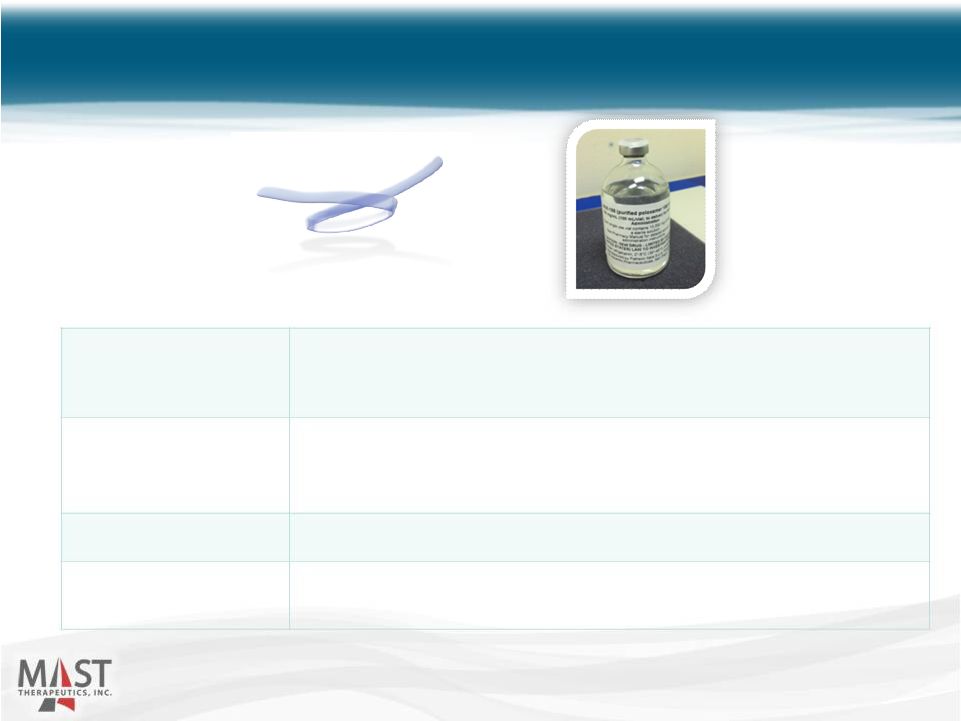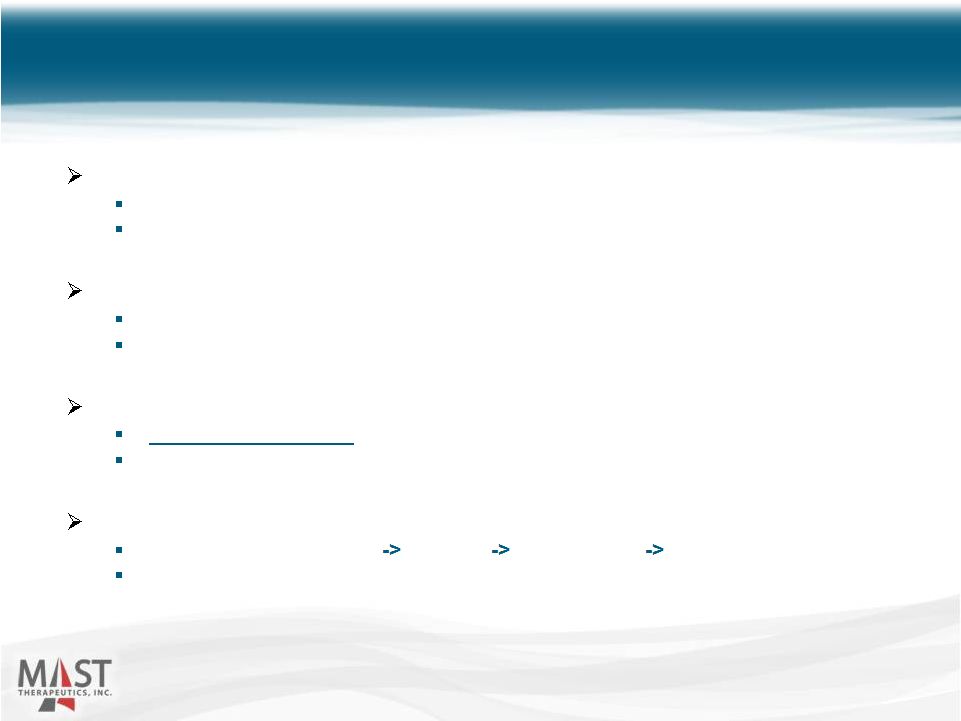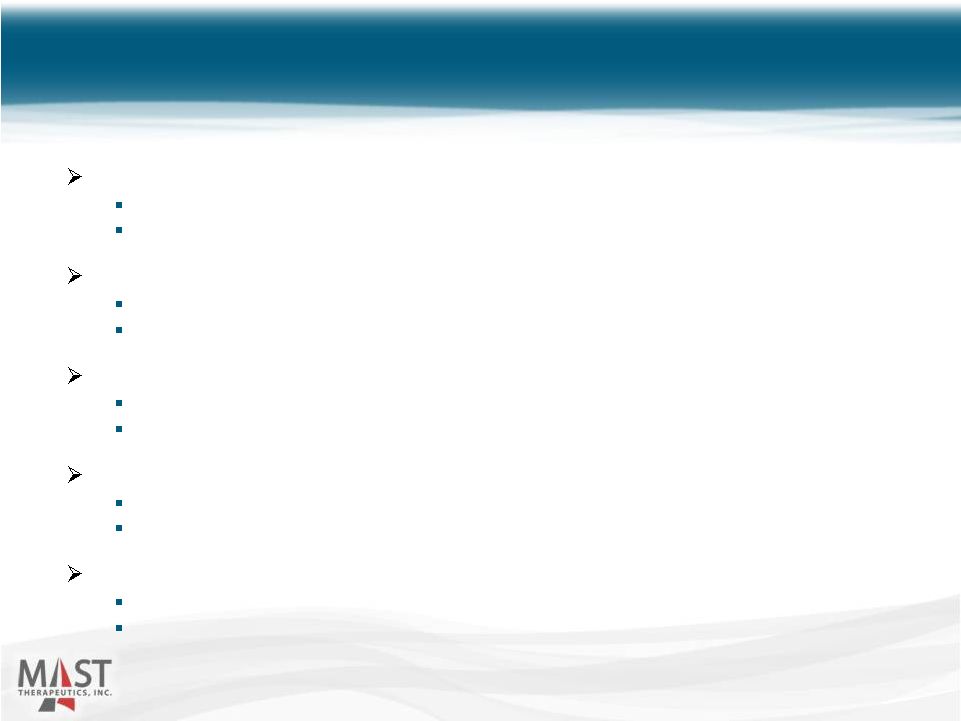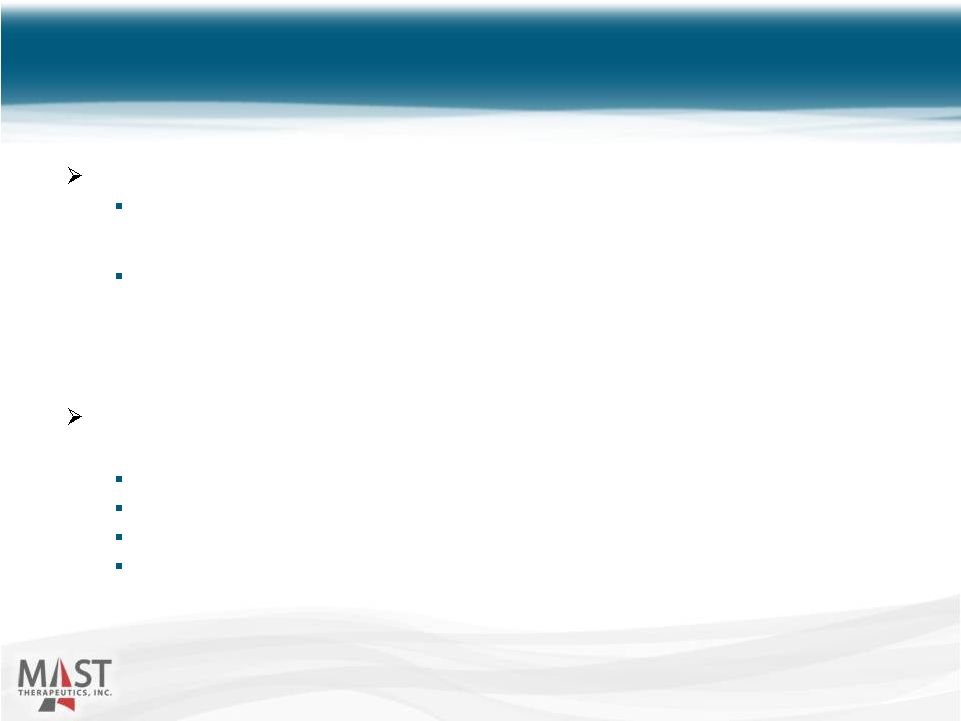Attached files
| file | filename |
|---|---|
| 8-K - 8-K - Savara Inc | d863629d8k.htm |
 NYSE
MKT: MSTX 2015 Canaccord Genuity Rare Disease,
2015 Canaccord Genuity Rare Disease,
Biopharma One on One Day
Biopharma One on One Day
Brian M. Culley, CEO
Brian M. Culley, CEO
February 3, 2015
February 3, 2015
Exhibit 99.1 |
 NYSE
MKT: MSTX 2
Forward-Looking Statements
This
presentation
includes
forward-looking
statements
about
our
business
prospects,
financial
position,
and
development
of
MST-188
and
AIR001
for
therapeutic
use
in
humans.
Any
statement
that
is
not
a
statement
of
historical
fact
should
be
considered
a
forward-looking
statement.
Because
forward-looking
statements
relate
to
the
future,
they
are
subject
to
inherent
risks,
uncertainties
and
changes
in
circumstances
that
are
difficult
to
predict.
Actual
events
or
performance
may
differ
materially
from
our
expectations
indicated
by
these
forward-
looking
statements
due
to
a
number
of
factors,
including,
but
not
limited
to,
results
of
our
pending
and
future
clinical
studies,
the
timeline
for
clinical
and
manufacturing
activities
and
regulatory
approval;
our
dependency
on
third
parties
to
conduct
our
clinical
studies
and
manufacture
our
clinical
trial
material;
our
ability
to
raise
additional
capital,
as
needed;
our
ability
to
establish
and
protect
proprietary
rights
related
to
our
product
candidates;
and
other
risks
and
uncertainties
more
fully
described
in
our
press
releases
and
our
filings
with
the
SEC,
including
our
annual
report
on
Form
10-K
filed
with
the
SEC
on
March
26,
2014.
We
caution
you
not
to
place
undue
reliance
on
any
of
these
forward-looking
statements,
which
speak
only
as
of
the
date
of
this
presentation.
We
do
not
intend
to
update
any
forward-looking
statement
included
in
this
presentation
to
reflect
events
or
circumstances
arising
after
the
date
of
the
presentation,
except
as
may
be
required
by
law. |
 NYSE
MKT: MSTX Developing vepoloxamer to improve
blood flow and cell membrane integrity
Sickle Cell Disease (SCD) –
Phase 3 enrolling (data expected Q1’16)
Acute Limb Ischemia (ALI) –
Phase 2 enrolling
Acute Heart Failure (ADHF) –
Phase 2 initiation Q2’15
Developing AIR001 to improve cardiovascular hemodynamics and
exercise tolerance
Heart Failure with Preserved Ejection Fraction (HFpEF) –
Phase 2a
3
Corporate Overview |
 NYSE
MKT: MSTX 4
Vepoloxamer
(Purified Poloxamer 188) |
 API
Structure: CMC:
•
Large, synthesized polymer with extraction process to
remove undesirable (toxic) components.
•
Composition of matter claims pending.
Administration:
•
IV infusion
ADME:
•
Rapidly and predominantly cleared by kidneys (4-8h)
•
Ether linkages cannot be cleaved; no drug metabolites
5
Vepoloxamer Overview
HO –
(CH
2
CH
2
O)
79
–
(CH
2
CHO)
30
–
(CH
2
CH
2
O)
79
–
H
CH
3
|
5
NYSE MKT: MSTX |
 NYSE
MKT: MSTX No Affinity for Healthy Cell
Membranes… But Adheres to Damaged Cell Membranes
Core of molecule adheres to hydrophobic domains on cell surface,
such as damaged membranes and adhesive proteins.
6
Vepoloxamer Mechanism of Action |
 NYSE
MKT: MSTX 7
Simple
biophysical
mechanism
improves
flow
and
membrane
integrity.
Vepoloxamer Pharmacodynamics
Hemorheologic
Inhibits cell adhesion,
reduces aggregation;
improves flow.
Vepoloxamer
Cytoprotective
Seals membranes,
restores integrity (e.g.
gives cells time to heal). |
 NYSE
MKT: MSTX Vepoloxamer
Clinical Development
8
Preclinical
Phase 1
Phase 2
Phase 3
2015
Sickle Cell Disease
(orphan)
Acute Limb Ischemia
(orphan)
Acute Heart Failure
Enrolling
Planned initiation: 2Q 2015
Enrolling |
 NYSE
MKT: MSTX 9
Sickle Cell Disease |
 NYSE MKT: MSTX
10
Overview of Sickle Cell Disease
A chronic, genetic disorder and rare (orphan) disease
Affects 90,000 to 100,000 people in the U.S.
Characterized by severe deformation (i.e., “sickling”) of red blood
cells Hallmark of disease is a “vaso-occlusive crisis”
Indescribably painful condition
Leading cause of hospitalization
Significant unmet need
No approved agents to shorten duration or severity of crisis
Standard of care (hydration and analgesics) unchanged for >10 years
Vaso-occlusion is associated with early death
Obstructed blood flow
hypoxia
tissue death
organ failure
Average age at death; 42 years (males), 48 years (females)
|
 NYSE MKT: MSTX
11
Vepoloxamer:
Reduces aggregation and adhesion of cells to endothelium
(anti-inflammatory) Improves RBC deformability, lowers viscosity, restores
flow (rheology), and reduces reperfusion injury (cytoprotection)
Vaso-Occlusion:
Adhesion
of
poorly-deformable,
“sticky”
cells
to
endothelium
Entrapment of rigid, sickled cells and vessel obstruction results in ischemia and
infarction Role of Vepoloxamer in Sickle Cell Disease
11 |
 NYSE MKT: MSTX
Lung
pathology
was
compared
in
transgenic
mice
pretreated
with
either
vepoloxamer
(400
mg/kg)
or
saline
and
subject
to
hypoxia
(5%
O
2
).
(Asakura,
et
al.)
Vepoloxamer Reduced Organ Pathology
in Transgenic Sickle Mice
12
Vepoloxamer
Control
Lung Pathology |
 NYSE MKT: MSTX
Transgenic mice pretreated with either vepoloxamer (400 mg/kg) or saline, subject to
hypoxia (5% O
2
), and monitored for survival. (Asakura, et al.)
Vepoloxamer Increased Survival in
Transgenic Sickle Mice
13
Vepoloxamer
Control
Survival of Transgenic Sickle Mice
Post
exposure
to
5%
0
2
(60
-
100%
ß
S
-Globin)
Time (min) |
 NYSE MKT: MSTX
Vepoloxamer
Placebo
Before Infusion
(Crisis Baseline)
0
0.2
0.4
0.6
0.8
1.0
1.2
1.4
1.6
1.8
2.0
2-Hours
7-Hours
After Loading
Infusion
After Loading
Infusion
Source: J. Investig. Med. 2004;52(6):402-6
(p = 0.00003)
14
Vepoloxamer improved microvascular blood flow in SCD patients in
crisis
14
Vepoloxamer Improves Blood Flow
Red cell velocity (mm/s)
measured by video
microscopy in nine
sickle cell patients with
vaso-occlusive crisis. |
 NYSE MKT: MSTX
Phase 2 Study
Source: Blood, September 1, 1997 –
Vol 90, No. 5
* Vepoloxamer is purified poloxamer 188
15
Subjects Who Received Full Dose
±
Poloxamer 188*
(n=18)
Placebo
(n=13)
p
value
±±
Duration of Crisis
44 hours
80 hours
0.025
Duration of Hospitalization
5 days
7 days
0.111
Total Analgesic Use
34mg
145mg
0.045
Parenteral Analgesic Use
27mg
133mg
0.022
±
Excludes patients who had drug administration errors or incomplete pain assessments
(16), who withdrew consent (2) and who withdrew because of injection
site
pain
after
15
minutes
of
infusion.
Subjects
were
excluded
equally
(n=9)
between
poloxamer
188
and
placebo.
±±
Proportional hazards model adjusted for baseline pain.
Randomized, double-blind, placebo-controlled, multi-center study in SCD
patients hospitalized for crisis
Significantly improved important efficacy parameters |
 Source:
JAMA,
November
17,
2001
–
Vol
286,
No.
17
16
Randomized, double-blind, placebo-
controlled, multi-center study of
vepoloxamer in 350 patients with SCD.
Time-to-event analysis showed
consistent trend in support of earlier
crisis resolution.
However, prior sponsor ended
enrollment at only 255 patients
due to
capital constraints, lowering statistical
power, and,
The observation period was specified
to
be
only
168
hours,
eliminating
observation of any late-treatment
differences (e.g. “right censoring”).
Phase 3 Study
16
All Treated Patients
(n=249)
Hours After Randomization
Children (<16 years)
(n=73)
NYSE MKT: MSTX |
 NYSE MKT: MSTX
Randomized, Double-Blind, Placebo-Controlled, Multicenter
388 patients
Standard of care +/-
vepoloxamer
Primary Efficacy Assessment
Duration of crisis (transition off IV analgesia)
No assessment of subjective pain scores
Secondary Efficacy Assessments
Re-hospitalization for crisis within 14 days
Occurrence of acute chest syndrome
Power
85% power to detect a 24-hour difference (p=0.01)
90% power to detect a 16-hour difference (p=0.05)
Open-label extension
Expands safety database with repeat exposures to vepoloxamer
Will enroll patients who have completed treatment on EPIC
17
EPIC: Pivotal Phase 3 Study Design |
 NYSE MKT: MSTX
Enrollment on-track. Top-line data expected Q1 2016.
~70 sites opened, >50 within the U.S.
>33% enrolled as of Jan 6.
Most Advanced New Drug in SCD
Potential to be first approved drug to treat an ongoing vaso-occlusive
crisis Substantial
head
start
versus
other
new
drugs
in
development
for
SCD
Positive Factors for Regulatory Decision-Making
Significant unmet need
Fast Track designation
Orphan Drug designation
Healthcare disparity
FDA declaration of SCD as an “agency priority”
18
EPIC Success Factors |
 NYSE MKT: MSTX
19
Acute Limb Ischemia
(Vepoloxamer In Combination with Thrombolytics) |
 A
progressive circulatory problem in which obstructed arteries reduce blood
flow to tissues
Thrombolytic agents (tPA) are used to treat acute complications
Significant morbidity and mortality
20
Acute Ischemic Cerebrovascular Infarction
(stroke)
Acute Myocardial Infarction
(heart attack)
Peripheral Arterial Disease
Intermittent Claudication
Critical Limb Ischemia
Acute Limb Ischemia
Development Strategy:
Develop initially in ALI
Expand into other AD markets
Overview of Occlusive Arterial Disease
NYSE MKT: MSTX |
 NYSE MKT: MSTX
21
Improved t-PA Effectiveness
Animals randomized to t-PA
(n = 10) or t-PA + poloxamer 188* (n = 10)
Source: Data on file
* Vepoloxamer is purified poloxamer 188
Time to Re-Occlusion
Time to Reperfusion |
 NYSE MKT: MSTX
22
Parameter
Poloxamer 188*
Control
Difference
p
Value
N=114
Myocardial
Infarct Size
(median)
16%
26%
38% reduction
0.031
Myocardial
Salvage (median)
13%
4%
125% increase
0.033
Ejection Fraction
(median)
52%
46%
13%
improvement
0.020
Incidence of
Reinfarction
1%
13%
92% reduction
0.016
Synergy with Thrombolytics
in Heart Attack
Source: Circulation 1996; 94: 298-307
*Vepoloxamer is purified poloxamer 188 |
 NYSE MKT: MSTX
23
Clinical Proof-of-Concept Study
Biomarkers
Clinical outcomes
Study Design
Randomized, double-blind, and active-controlled (t-PA)
t-PA +/-
low or high dose vepoloxamer
60 subjects (20 per arm)
Timing
Completion of enrollment anticipated 2H 2016
ALI data can be supportive of clinical development in stroke
Embolic stroke preclinical studies initiated
Phase 2 Study in ALI |
 NYSE MKT: MSTX
24
Heart Failure |
 NYSE MKT: MSTX
Overview of Heart Failure
25
Chronic condition characterized by decreasing heart function
Heart cannot pump enough blood to meet the body’s needs
Significant Unmet Medical Need
Leading healthcare cost in U.S. and Europe
Substantial and Growing Market Opportunity
> 5 million individuals with heart failure in the U.S.
Acute Decompensation
Each decompensation event contributes to worsening heart failure
and damage to
vital organs, decreasing survival probability following the next
event
Vepoloxamer
Membrane-sealant activity may restore weakened cardiac cell membranes,
minimizing calcium overload injury
Durable effect may indicate a direct improvement in cardiac function
|
 NYSE MKT: MSTX
In heart failure, elevated wall tension impairs lipid flow and
membrane repair. This results in calcium influx and cardiac
troponin leak.
Vepoloxamer re-seals membranes and reduces membrane
tensions, enabling lipid flow and facilitating membrane repair,
thus reducing cardiac troponin and calcium overload damage.
Heart Failure Development Rationale
26 |
 Non-clinical Model of Heart Failure
27
A
single,
2h
infusion
improved
hemodynamic
parameters
(LVEF,
CO)
and
biomarkers correlated with clinical outcomes (troponin, NT-proBNP)
A potentially novel mechanism, compatible with existing treatments
Planning to initiate Phase 2 in acute decompensated HF in Q2 2015
Source: data on-file
NYSE MKT: MSTX |
 NYSE MKT: MSTX
28
AIR001
(sodium nitrite) inhalation solution |
 NYSE MKT: MSTX
AIR001 is nitrite for intermittent inhalation (via nebulizer)
Beneficial effects include dilation of blood vessels
and reduced inflammation
Positive hemodynamic effects; reductions observed in:
–
pulmonary vascular resistance
–
pulmonary capillary wedge pressure
–
right atrial pressure
AIR001 is being developed for Heart Failure with Preserved
Ejection Fraction (HFpEF)
Responsible for ~50% of heart failure hospitalizations
80% develop Pulmonary Hypertension
Leads to shortness of breath, dizziness, fainting, leg swelling,
etc.
No approved medications
29
AIR001 |
 NYSE MKT: MSTX
Three Phase 1 studies:
Established MTD and safe dose level
Confirmed conversion of nitrite to nitric oxide (NO)
Acute improvements in hypoxia-induced pulmonary hypertension
No drug-drug interaction with sildenafil
One Phase 2 study:
Well-tolerated, with no treatment-related serious adverse events
All doses showed improvement in median pulmonary vascular
resistance (PVR) & median distances obtained in the 6-minute walk test
Methemoglobin levels remained normal (< 1.5%)
Safety data in 124 healthy volunteers and patients with
various forms of pulmonary hypertension (well-tolerated)
30
AIR001 Clinical Data |
 NYSE MKT: MSTX
Supporting three institution-sponsored Phase 2a studies to:
Evaluate acute hemodynamic effects of AIR001
Evaluate acute effects versus placebo on maximum oxygen consumption and
exercise hemodynamics
Evaluate inhaled versus intravenous administration of nitrite and safety of
multiple doses of AIR001
Preliminary data anticipated 2H 2015
If positive, conduct Phase 2b proof-of-concept
31
AIR001 Clinical Development Plan |
 NYSE MKT: MSTX
32
Upcoming News & Events
Initiate dosing in Phase 2a studies of AIR001
Q1 ’15
Report data from nonclinical study of vepoloxamer in embolic stroke
Q1 ’15
Report data from nonclinical study of vepoloxamer in heart failure
Q1 ’15
Initiate enrollment in EPIC extension study (repeat exposure) (EPIC-E)
1H ’15
Initiate enrollment in Phase 2 study of vepoloxamer in heart failure
Q2 ’15
Complete enrollment in EPIC study
Q4 ’15
Report data from Phase 2a study of AIR001 in HFpEF
2H ’15
Report
interim
safety
from
Phase
2
study
of
vepoloxamer
in
heart
failure
2H ’15
Report EPIC study top-line data
Q1 ’16
Complete enrollment in Phase 2 study of vepoloxamer in ALI
2H ’16 |
 NYSE MKT: MSTX
Cash/investments at 12/31/14: $57 million
Market capitalization: ~$75 million*
Shares outstanding: ~159 million*
Average daily volume (3 mo): ~900,000*
No debt
33
* As of January 26, 2015
MSTX Financial Overview |
 NYSE MKT: MSTX
A Leader in Areas of Significant Unmet Need (Vepoloxamer)
Sickle Cell Disease: Most advanced new drug in development
Arterial Disease: Ongoing Phase 2 in ALI with opportunity in stroke
Heart Failure: Phase 2 study to begin Q2 2015
AIR001
Phase 2 program in heart failure with preserved ejection fraction
Multiple phase 2a studies planned/ongoing
Multiple clinical readouts anticipated within 15 months
Sickle cell: Phase 3 top-line
Heart failure: Phase 2 (interim safety data)
HFpEF: Phase 2a studies
34
Mast Investment Summary |
